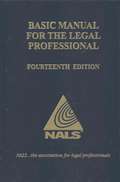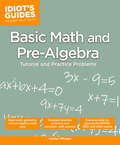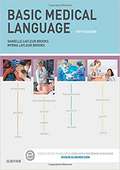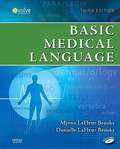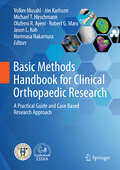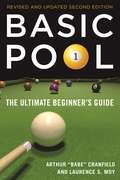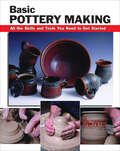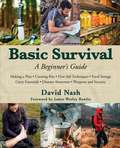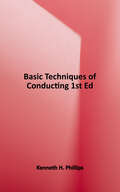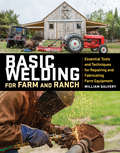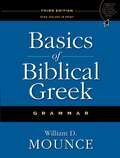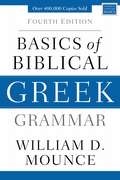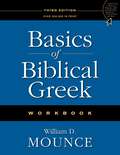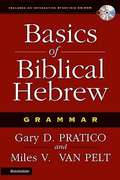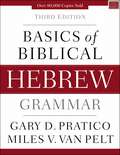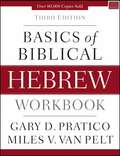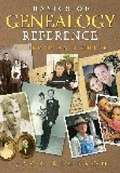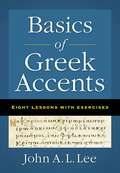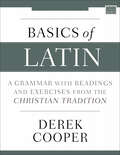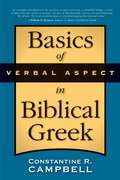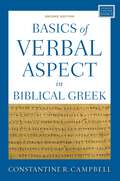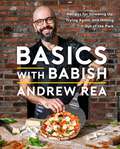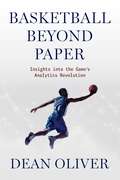- Table View
- List View
Basic Manual for the Legal Professional
by NalsNALS Basic Manual for the Lawyer's Assistant, 14th, a guide for legal professionals, lays out legal principles and approved law office procedures for those who have previous experience in the legal fields. It assumes a working knowledge of legal terminology and law office procedure, and includes chapters on career development, ethics, law office management, computer information systems, and accounting, legal writing and legal research, the courts and administrative agencies, trial preparation, civil procedure, and criminal procedure, Torts, contracts, real estate transactions, landlord and tenant, estate planning, estates, guardianships, and family law, business organizations, bankruptcy, taxation, and arbitration, environmental law, water law, and oil and gas law, labor law, intellectual property law, pension and profit sharing plans, and workers' compensation law, admiralty and maritime law, antitrust law, and immigration law, and Federal civil rights and employment discrimination laws. Easy-to-read charts, diagrams, and illustrations provides practical guidance on topics the successful lawyer's assistant must address every day. A bibliography, several glossaries and index are also included.
Basic Math and Pre-Algebra: Tutorial and Practice Problems (Idiot's Guides)
by Carolyn WheaterIdiot's Guides: Basic Math and Pre-Algebra helps readers get up to speed and relearn the primary concepts of mathematics, geometry, and pre-algebra. Content includes basic math operations (addition, subtraction, multiplication, division); word problems; factors and multiples; fractions, decimals, and percents; weights and measures; graphs; statistics and probability; and algebra and geometry basics. A practice problems section is also included to help reinforce the math concepts. This book is ideal for anyone needing a refresher in order to pass entrance exams, such as the GED®, ASVAB, and Praxis®.
Basic Medical Language
by Danielle S. LaFleur Myrna LaFleur-BrooksBasic Medical Language by Danielle S LaFleur (Author), Myrna LaFleur-Brooks (Contributor)
Basic Medical Language (Third Edition)
by Myrna Lafleur Brooks Danielle Lafleur BrooksFocused on the basic word analysis skills you need for medical terminology, Basic Medical Language, 3rd Edition includes a carefully selected group of suffixes, prefixes, and word roots to give you a foundation for recognizing and communicating medical terms. A combination of body system lessons, anatomy presentations, and introductions to word parts reinforce basic word building skills. Plus, you can take charge of your learning with the companion CD packaged with the text and an online audio program for additional practice. Beginning with word parts and moving on to whole words, the systematic presentation equips you to recognize and define new words as you encounter them. A variety of learning exercises tests your knowledge and provides instant feedback on your progress. The Abbreviations tables include the most common medical abbreviations you'll encounter in the healthcare setting. Review sections within each lesson reinforce your learning. Consistent organization and pacing of lessons steadily build your knowledge and vocabulary. Coverage of every body system ensures you have all the basic medical terminology content you need. FYI boxes include practical and interesting information to spark your curiosity. Over 200 flash cards printed on card stock and bound with the book provide a portable way to study. At-a-Glance sections provide a quick review to help you get the most out of each lesson. New illustrations and diagnostic images show the latest developments in the clinical environment. Exercises like Interact with Medical Documents and others help you understand and use terms with the documents you'll use in practice. Outline/Objectives highlight the most important information for each chapter. Icons throughout the text direct you to the companion CD to enhance your learning experience. Two new games, updated activities, and animations on the companion CD reinforce your learning and provide additional background for pathologies and procedures in the text. The online audio program ensures proper pronunciation of terms.
Basic Methods Handbook for Clinical Orthopaedic Research: A Practical Guide And Case Based Research Approach
by Robert G. Marx Norimasa Nakamura Michael T. Hirschmann Olufemi R. Ayeni Jón Karlsson Volker Musahl Jason L. KohThis book is designed to meet the needs of both novice and senior researchers in Orthopaedics by providing the essential, clinically relevant knowledge on research methodology that is sometimes overlooked during training. Readers will find a wealth of easy-to-understand information on all relevant aspects, from protocol design, the fundamentals of statistics, and the use of computer-based tools through to the performance of clinical studies with different levels of evidence, multicenter studies, systematic reviews, meta-analyses, and economic health care studies. A key feature is a series of typical case examples that will facilitate use of the volume as a handbook for most common research approaches and study types. Younger researchers will also appreciate the guidance on preparation of abstracts, poster and paper presentations, grant applications, and publications. The authors are internationally renowned orthopaedic surgeons with extensive research experience and the book is published in collaboration with ISAKOS.
Basic Pool: The Ultimate Beginner's Guide
by Arthur Babe" Cranfield Laurence S. MoyIn the game of pool, few names hold more weight than Arthur "Babe" Cranfield. Ranked among the best billiard players in world history, Cranfield is unarguably one of the greats of the game. And in this newly revised and updated edition of Basic Pool, you can learn proven tips and tactics to help you improve your game. From basics like choosing a table and selecting a cue to advanced techniques like manipulating the ball using English, draw, and follow, Basic Pool has all you need to elevate your play and increase the enjoyment you take from it. Other topics include: The mechanics of pool Cue ball control Standard rules of the most popular variations Effective practice techniques And many more!Whether you are pool novice or have been playing for years, Basic Pool is sure to provide you with the knowledge that you need to take your pool skills to.
Basic Pottery Making: All the Skills and Tools You Need to Get Started (How To Basics)
by Linda FranzAn illustrated guide to the fundamentals of pottery making with straightforward, expert instruction and four projects for the beginner potter. Complete with a chapter on tools and materials to get started, this easy-to-use guide explains and illustrates how to wedge clay, use a pottery wheel, shape and trim pots, determine clay thickness, add handles, and a host of other pottery-making techniques. It also contains a chapter on bisque firing and glazing, the final steps in creating beautiful and functional pottery. Includes complete instructions for making a large bowl, three styles of mugs, and a sugar bowl and creamer set.
Basic Survival: A Beginner's Guide
by James Wesley Rawles David NashMany people are beginning to become concerned by increasing natural disasters, global conflict, and political unrest and the smart ones want to do something about it. Unfortunately, increased awareness about disaster preparedness has caused an information overload. It is easy to become overwhelmed by the sheer amount of information available. Basic Survival helps readers dig out from under the avalanche of preparedness information. It dispels myths, introduces concepts, and teaches the basics of how to start preparing for disaster. Author David Nash, a lifelong prepper and the author of 52 Prepper Projects and The Prepper’s Guide to Foraging outlines an all-hazards approach to disaster management similar to the ones used by the military and federal and state governments. Nash has over ten years of experience in government emergency management as a planner, a first responder, and as an emergency operations center manager. Basic Survival is a great resource that presents a strong foundation for being prepared when an emergency hits.
Basic Techniques of Conducting
by Kenneth H. PhillipsSystematic, practical, and thorough, this book offers a clear instructional strategy and a basic methodology for teaching the physical gestures and concepts essential for the development of a convincing conducting technique. Taking a competency-based approach, this text provides a clear, step-by-step system for mastering the physical gestures required for good conducting. Paying special attention to the psychomotor skills needed for clear and expressive conducting establishes a solid foundation on which to build an advanced and personal conducting style. <p><p>Based on ten years of teaching and class-testing, the text is carefully organized to establish essential conducting skills over a one-semester period. Each of the thirty lessons introduces basic conducting techniques in a developmental sequence and includes a review of previous techniques," guided practice" segments for group practice of new techniques, and "assignment" sections for independent study and practice. <p><p>The text is fully illustrated with many conducting diagrams, photographs of hand and body movements, and numerous musical examples for directed conducting practice. Emphasizing complete musical examples rather than short excerpts, it features both choral and instrumental exercises for drill and practice. Engaging and accessible, Basic Techniques of Conducting offers all of the content necessary to build a solid foundation of conducting skills for all vocal and instrumental music education majors.
Basic Welding for Farm and Ranch: Essential Tools and Techniques for Repairing and Fabricating Farm Equipment
by William GalveryFarmers, ranchers, and homesteaders who know how to weld can repair and even fabricate some equipment on their own, saving both time and money. Basic Welding for Farm and Ranch introduces this crucial skill and covers the most popular techniques used by the home hobbyist and DIY devotee, with chapters and detailed illustrations dedicated to oxyacetylene welding (or gas welding), stick welding, MIG, and arc welding, as well as brazing and soldering. Along with guidance on equipment selection and use, and safety precautions, this book offers 12 projects and repairs commonly faced on the small farm or homestead, with step-by-step photography guiding readers through building a wall-mount hay feeder, repairing a garden rake, making horseshoe hooks, and more. This publication conforms to the EPUB Accessibility specification at WCAG 2.0 Level AA.
Basics of Biblical Greek Grammar
by William D. MounceFirst published in 1993, Basics of Biblical Greek is the most popular introduction to the field, used in universities and seminaries around the world. Over 200,000 students have learned biblical Greek under its guidance. This significant third edition has been carefully developed in consultation with instructors, students, self-learners, and homeschoolers. Users can now take advantage to the many improvements made at the book’s website, www.Teknia.com, where they will find—for free—an online course, walking students through every chapter; vocabulary flashcards; video and audio helps; Greek fonts; quizzes for each chapter; fun songs and games; and much, much more. Now in a larger size, with an attractive 2-color design, the third edition adds an element of fun, with encouragement, songs, and more, which appear in the margins. Chapter 35 has been split into two chapters, “half-time review” sections have been added to every chapter, and new exegesis sections are now included. These and other improvements serve to enhance the learning experience and will continue BBG’s legacy as the premier introduction to biblical Greek.
Basics of Biblical Greek Grammar: Fourth Edition
by William D. MounceClear. Understandable. Carefully organized. Basics of Biblical Greek Grammar by William D. Mounce is the standard textbook for colleges and seminaries. Since its initial publication in 1993 its integrated approach has helped more than 250,000 students learn New Testament Greek.The fourth edition of Basics of Biblical Greek Grammar has been updated throughout based on continuing feedback from professors, students, self-learners, and homeschoolers, making it even more effective for today’s students. As well, improvements have been made based on recent developments in scholarship.The key to the effectiveness of Basics of Biblical Greek Grammar in helping students learn is in how it introduces them to the language. Students learn about the features of the Greek language in a logical order, with each lesson building upon the one before it. Unnecessary obstacles that discourage students and hinder progress are removed, such as rote memorization of endless verbal paradigms. Instead students receive encouragement along the way to assure them they are making the necessary progress. As well, detailed discussions are included at key junctures to help students grasp important concepts.By the time students have worked their way through Basics of Biblical Greek Grammar they will have learned:The Greek AlphabetVocabulary for words occurring 50 times or more in the Greek New TestamentThe Greek noun systemThe Greek verbal system, including indicative and nonindicative verbs, and participlesA robust suite of learning aids is available for purchase to be used alongside the textbook to help students excel in their studies. These include a workbook, video lectures for each chapter featuring the author, flashcards keyed to vocabulary in each chapter, a laminated quick study sheet with key concepts, and audio of the vocabulary for each chapter to aid in acquisition.
Basics of Biblical Greek Grammar: Fourth Edition (Zondervan Language Basics Series)
by William D. MounceClear. Understandable. Carefully organized. Basics of Biblical Greek Grammar by William D. Mounce is the standard textbook for colleges and seminaries. Since its initial publication in 1993 its integrated approach has helped more than 250,000 students learn New Testament Greek.The fourth edition of Basics of Biblical Greek Grammar has been updated throughout based on continuing feedback from professors, students, self-learners, and homeschoolers, making it even more effective for today’s students. As well, improvements have been made based on recent developments in scholarship.The key to the effectiveness of Basics of Biblical Greek Grammar in helping students learn is in how it introduces them to the language. Students learn about the features of the Greek language in a logical order, with each lesson building upon the one before it. Unnecessary obstacles that discourage students and hinder progress are removed, such as rote memorization of endless verbal paradigms. Instead students receive encouragement along the way to assure them they are making the necessary progress. As well, detailed discussions are included at key junctures to help students grasp important concepts.By the time students have worked their way through Basics of Biblical Greek Grammar they will have learned:The Greek AlphabetVocabulary for words occurring 50 times or more in the Greek New TestamentThe Greek noun systemThe Greek verbal system, including indicative and nonindicative verbs, and participlesA robust suite of learning aids is available for purchase to be used alongside the textbook to help students excel in their studies. These include a workbook, video lectures for each chapter featuring the author, flashcards keyed to vocabulary in each chapter, a laminated quick study sheet with key concepts, and audio of the vocabulary for each chapter to aid in acquisition.
Basics of Biblical Greek Workbook
by William D. MounceThis expanded and updated workbook is designed with the student in mind and intended for use with the standard-setting Basics of Biblical Greek Grammar textbook, now in its fourth edition.Two optional chapters have been added to the Basics of Biblical Greek Workbook, allowing students to read large chunks of the biblical text and enjoy the fruits of their labor faster than ever before. Each chapter is divided into six sections and includes extensive exercises and significant biblical passages for translation.One of the most helpful and unique features of the workbook remains. You can go through the workbook on one of two tracks: Track One follows the workbook (and textbook) in its regular order, while Track Two is organized so you can learn verbs earlier in the course.
Basics of Biblical Greek Workbook
by William D. MounceExpanded, student-friendly workbook for use with Basics of Biblical Greek textbook This expanded workbook is designed with you, the student, in mind and intended for use with the standard-setting Basics of Biblical Greek textbook, now in its third edition. Two optional chapters have been added to the Basics of Biblical Greek Workbook, allowing you to read large chunks of the biblical text and enjoy the fruits of your labor faster than ever before. Each chapter is divided into six sections and includes extensive exercises and significant biblical passages for translation. One of the most helpful and unique features of the workbook remains. You can go through the workbook on one of two tracks: Track 1 follows the workbook (and textbook) in its regular order, while Track 2 is organized so you can learn verbs earlier in the course. You will also benefit from the many resources at www.Teknia.com. Not only is the flexible two-track system even easier to use online, but a workbook answer key is also provided. Many other resources are available, including vocabulary flashcards; video and audio helps; Greek fonts; quizzes for each chapter; fun songs and games; and much, much more. Now available (show covers for: laminated study sheet, vocabulary cards)
Basics of Biblical Hebrew Grammar
by Gary D. Pratico Miles V. Van PeltFeatures of Basics of Biblical Hebrew Grammar, Second Edition text: * Combines the best of inductive and deductive approaches * Uses actual examples from the Hebrew Old Testament rather than 'made-up' illustrations * Emphasizes the structural pattern of the Hebrew language rather than rote memorization, resulting in a simple, enjoyable, and effective learning process * Colored text highlights particles added to nouns and verbs, allowing easy recognition of new forms * Chapters Two (Hebrew Vowels), Nine (Pronominal Suffixes), Seventeen (Waw Consecutive), Eighteen (Imperative, Cohortative, and Jussive), and Twenty-Three (Issues of Sentence Syntax) are revised and expanded * Section of appendices and study aids is clearly marked for fast reference * Larger font and text size make reading easier * Updated author website with additional Hebrew language resources and product information (www.basicsofbiblicalhebrew.com) Features of updated CD-ROM: * Full answer key to the accompanying workbook (compatible with Windows and Macintosh) * Scripture indexes to both the grammar and the workbook. <P> <i>Advisory: Bookshare has learned that this book offers only partial accessibility. We have kept it in the collection because it is useful for some of our members. To explore further access options with us, please contact us through the Book Quality link on the right sidebar. Benetech is actively working on projects to improve accessibility issues such as these. </i>
Basics of Biblical Hebrew Grammar: Third Edition (Zondervan Language Basics Series)
by Gary D. Pratico Miles V. Van PeltClear. Understandable. Carefully organized. Basics of Biblical Hebrew Grammar by Gary D. Pratico and Miles V. Van Pelt is the standard textbook for colleges and seminaries. Since its initial publication in 2001 its integrated approach has helped more than 80,000 students learn Biblical Hebrew.The third edition of Basics of Biblical Hebrew Grammar represents a significant updating and revision of the previous edition with the goal of providing students with the best possible tool for learning Biblical Hebrew. Some of the keys to the effectiveness of Basics of Biblical Hebrew Grammar in helping students learn is that it:Combines the best of inductive and deductive approachesUses actual examples from the Hebrew Old Testament rather than &“made-up&” illustrationsEmphasizes the structural pattern of the Hebrew language rather than rote memorization, resulting in a simple, enjoyable, and effective learning processEmploys colored text that highlights key features of nouns and verbs, allowing easy recognition of new formsIncludes appendices of verbal paradigms and diagnostics for fast reference and a complete vocabulary glossaryDisplays larger font and text size, making reading easierBy the time students have worked their way through Basics of Biblical Hebrew Grammar they will have learned:The Hebrew AlphabetVocabulary for words occurring 70 times or more in the Hebrew BibleThe Hebrew noun systemThe Hebrew verbal systemA robust suite of learning aids is available for purchase to be used alongside the textbook to help students excel in their studies. These include a workbook; video lectures for each chapter featuring the author; flashcards keyed to vocabulary in each chapter; a laminated study sheet with key concepts; audio of the vocabulary for each chapter to aid in acquisition; and a compact guide to help refresh students refresh their memory on language forms, grammar, and word meanings.
Basics of Biblical Hebrew Workbook: Third Edition (Zondervan Language Basics Series)
by Gary D. Pratico Miles V. Van PeltThis updated workbook is designed with the student in mind and intended for use with the standard-setting Basics of Biblical Hebrew Grammar textbook, now in its third edition. In addition to corresponding to the revisions and updates in Basics of Biblical Hebrew Grammar, this workbook includes significant changes to the interior presentation; less unnecessary questions and exercises; and six reading texts interspersed among the exercises for the derived stems.The workbook is an essential chapter-by-chapter companion and includes helpful exercises and translation homework. As students complete the assignments in the workbook, the concepts they have been learning from the main grammar are reinforced, making this an invaluable study tool to enhance student learning.
Basics of Genealogy Reference
by Jack SimpsonThis book offers novice and experienced reference librarians an introduction to tried-and-true genealogy techniques and resources. With the help of four case studies, Simpson outlines a basic starting strategy for conducting genealogy research. Later chapters deal specifically with genealogical librarianship: how to conduct a reference interview, continuing and professional development, and basic resources every collection should have. Charts, screen shots, and examples of public documents are also included; while a series of appendices present the case studies in their entirety.
Basics of Greek Accents: Eight Lessons with Exercises
by John A. LeeBasics of Greek Accents by John A. L. Lee is a compact, student-friendly, and practical guide to accents for students of both classical and biblical Greek. In eight simple lessons students will learn the basics of ancient Greek accentuation.Ideal for beginners who are just learning the language or for intermediate students who have learned some Greek but are unsure of their accents this handy resource avoids theory and concentrates on taking the learner through the essentials in a natural sequence and reinforces learning by means of simple exercises.
Basics of Latin: A Grammar with Readings and Exercises from the Christian Tradition
by Derek CooperBasics of Latin: A Grammar with Readings and Exercises from the Christian Tradition by Derek Cooper introduces students, independent learners, and homeschoolers to the basics of Latin grammar with all readings and exercises taken from texts in the Christian tradition.As part of the widely-used Zondervan Language Basics series of resources, Cooper's Latin grammar is a student-friendly introduction. It helps students learn by:Minimizing technical jargonProviding only the information needed to learn the basicsBreaking the grammar of language down into manageable and intuitive chunksIllustrating the grammar in question by its use in rich selections from ancient Christian authors.Providing grammar, readings, exercises, and a lexicon all in one convenient volume.Basics of Latin provides an ideal first step into this important language and focuses on getting the student into texts and translation as quickly as possible.
Basics of Verbal Aspect in Biblical Greek
by Constantine R. CampbellVerbal aspect in the Greek language has been a topic of significant debate in recent scholarship. The majority of scholars now believe that an understanding of verbal aspect is even more important than verb tense (past, present, etc.). Until now, however, there have been no accessible textbooks, both in terms of level and price (most titles on the topic retail for more than $100). In this book, Constantine Campbell investigates the function of verbal aspect within the New Testament Greek narrative. He has done a marvelous job in this book of simplifying the concept without getting caught up using terms of linguistics that no one except those schooled in that field can understand. The book includes exercises, an answer key, glossary of key concepts, an appendix covering space and time, and an index to Scripture cited. Professors and students, at both the undergraduate and graduate levels, will use this is as a supplemental text in both beginning and advanced Greek courses. Pastors that study the Greek text will also appreciate this resource as a supplement to their preaching and teaching.
Basics of Verbal Aspect in Biblical Greek: Second Edition (Zondervan Language Basics Series)
by Constantine R. CampbellVerbal aspect in the Greek language has been a topic of significant debate in recent scholarship. The majority of scholars now believe that an understanding of verbal aspect is even more important than verb tense (past, present, etc.). Yet there still are no alternative accessible textbooks, both in terms of level and price. In the second edition, Constantine R. Campbell investigates the function of verbal aspect within the New Testament Greek narrative in light of the last fifteen years of the latest scholarship.In Basics of Verbal Aspect in Biblical Greek, Second Edition, Campbell has done a marvelous job in this book of simplifying the concept without getting caught up using terms of linguistics that only experts can understand. The book includes expanded and updated discussion, revised exercises, an answer key, a glossary of key concepts, an appendix covering space and time, and an index of Scriptures cited. Professors and students, at both the undergraduate and graduate levels, will use this is as a supplemental text in both beginning and advanced Greek courses. Pastors that study the Greek text will also appreciate this resource as a supplement to their preaching and teaching.
Basics with Babish: Recipes for Screwing Up, Trying Again, and Hitting It Out of the Park (A Cookbook)
by Andrew ReaNEW YORK TIMES BESTSELLER NAMED A BEST COOKBOOK OF FALL 2023 BY FOOD & WINE, DELISH, and TASTING TABLE Over 100 easy-to-follow recipes that teach you how to learn from your mistakes and become a better cook, from the culinary genius who created the Babish Culinary Universe YouTube channel in this long-awaited companion.In his wildly popular Basics with Babish series, YouTube star Andrew Rea, who has amassed millions of subscribers, attempts, often fails, but always teaches cooking techniques for all levels of cooks. He&’s explained everything from how to make challah bread and English muffins to Asian dumplings and homemade bacon. Now those classic, essential recipes (and many more) are compiled into an authoritative cookbook which contains hundreds of step-by-step photographs with tips and tricks to help you troubleshoot anything from broken butter to burnt bread to bony branzino. Basics with Babish isn&’t just a kitchen Bible for a new generation of home chefs, it&’s a proud reclamation of mistakes which encourages you to learn from your and Andrew&’s missteps alike. Andrew Rea launched Binging with Babish on YouTube in 2016, recreating and reimagining dishes from famous television programs and movies inspired by everything from Mad Men to The Simpsons to Game of Thrones. The tie-in cookbook, Binging with Babish, was an instant New York Times bestseller, and fans of that book and countless more will delight in this new cookbook which will truly teach you how to cook, with Rea&’s beloved sense of humor and guiding hand throughout.
Basketball beyond Paper: Insights into the Game's Analytics Revolution
by Dean OliverA pioneer in the field of basketball analytics, Dean Oliver introduced a framework to understand basketball through the use of statistics in his book Basketball on Paper. In his follow-up, Basketball beyond Paper, Oliver lays out both the technical and personal aspects of his twenty-year experience in the NBA as he helped build the analytics that changed the game. He also looks at the people and technology that pushed those analytics forward. Oliver tells stories of how the insights came about, whether studying other teams or witnessing events with players, coaches, and management of his own teams. He highlights how great LeBron James and Steph Curry have been but also how critical &“middle-class&” or &“glue&” players such as Shane Battier, Andre Iguodala, and JJ Redick were to their teams. Oliver illustrates the paths taken by Most Improved Player Award winners such as Lauri Markkanen, Julius Randle, and Brandon Ingram. Basketball beyond Paper tells the stories of how analytics have helped basketball players, coaches, and management—and changed the game.
